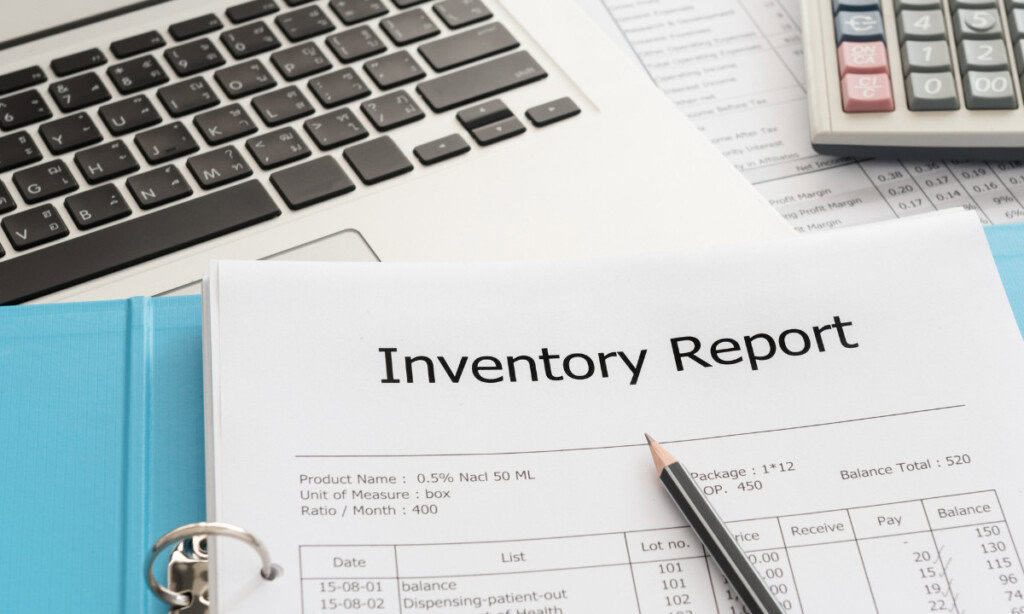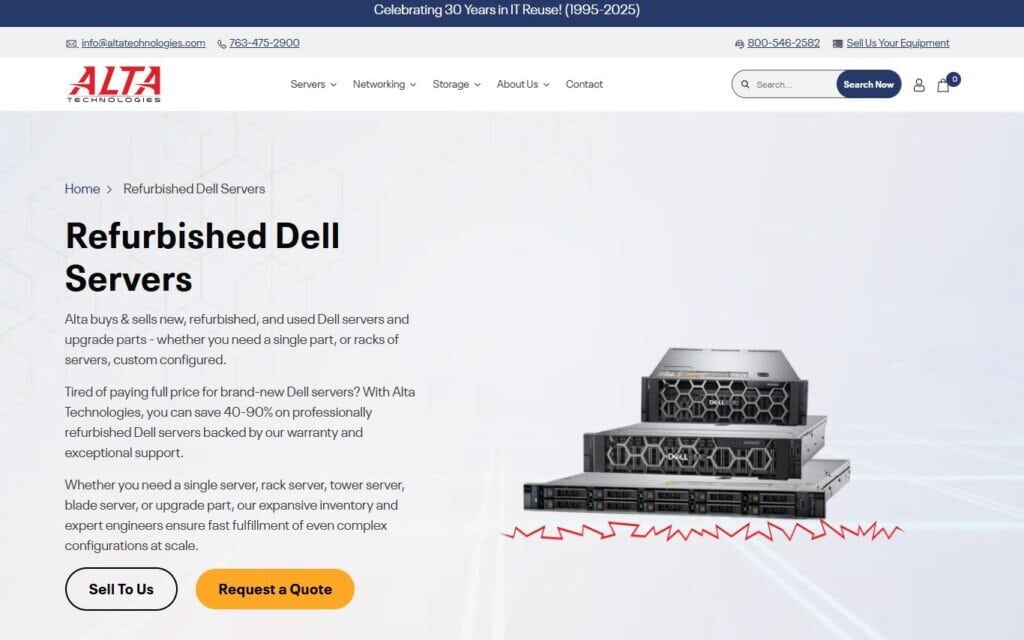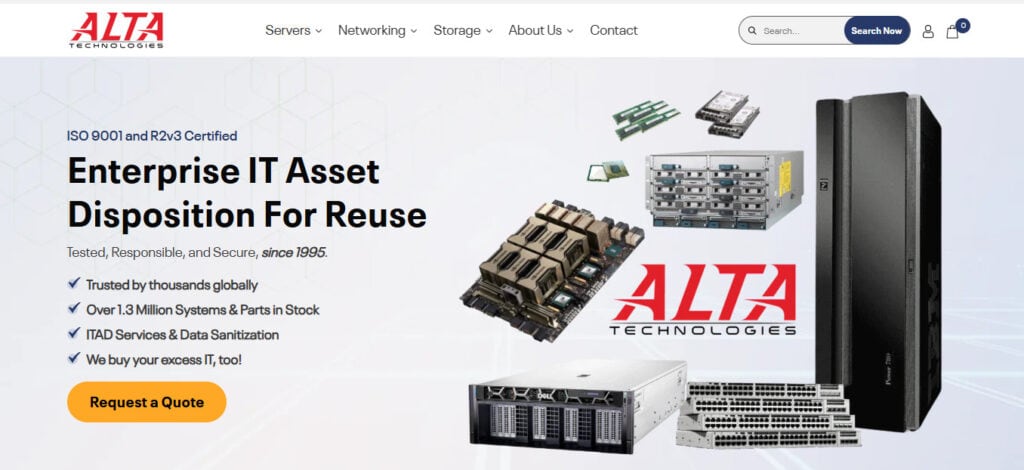- TL;DR – Quick Take on ITAD Costs & ROI
- Step 1: Assessment and Planning
- Step 2: Data Sanitization
- Step 3: Hardware Removal
- Step 4: Asset Resale vs. Recycling
- Step 5: Logistics and Chain of Custody
- Step 6: Compliance Reporting and Documentation
- What ITAD Really Costs
- Step 7: Leadership Considerations and ESG Strategy
- Step 8: Vendor Selection Insights
- Step 9: Common Risks and Mitigation
- Step 10: A Repeatable ITAD Checklist
- Wrapping It Up
- Executive ITAD Overview Table with Estimated Costs & ROI P.1
- Executive ITAD Overview Table with Estimated Costs & ROI P.2
Last Updated on September 21, 2025 by Ewen Finser
Enterprise IT asset disposition (ITAD) is no longer a niche back-office chore that only IT managers worry about. For digital-first businesses — whether that’s SaaS providers, e-commerce platforms, digital agencies, managed service providers, or publishers — ITAD directly affects data security, regulatory compliance, operational continuity, and financial ROI.
When handled poorly, decommissioning hardware can trigger data breaches, seven-figure regulatory fines, downtime during migrations, and wasted hardware value. On the other hand, when handled strategically, ITAD can return capital to the business, demonstrate environmental responsibility, and prove governance strength to clients and investors.
I want to provide a step-by-step roadmap for enterprise ITAD here. Along the way, you’ll see real-world cost ranges, examples of ROI, and leadership-level considerations for making ITAD not just safe, but profitable.
TL;DR – Quick Take on ITAD Costs & ROI
Enterprise IT asset disposition (ITAD) is more than a compliance checkbox—it’s a strategic opportunity. Properly executed, ITAD protects sensitive data, ensures regulatory compliance, supports ESG goals, and recovers significant hardware value. Expect costs roughly $50–$200 per server and $25–$75 per laptop/desktop for assessment, removal, and data sanitization. Resale can recover 20–50% of hardware value, while certified recycling costs $25–$75 per unit. Choosing a trusted ITAD partner, like Alta Technologies, ensures engineering-led testing, secure logistics, verifiable data destruction, and global resale options—turning retired hardware from a liability into a measurable business benefit.
Step 1: Assessment and Planning
The first — and often most overlooked — phase of ITAD is assessment and planning. Before a single server is unplugged, leadership should be asking:
- What risks do these assets represent if not disposed of correctly?
- What resale value could be recovered?
- How does this align with regulatory obligations (GDPR, HIPAA, SOX, PCI DSS)?
- How much operational downtime can we tolerate during the transition?
Activities in this Stage Include:

- Detailed inventorying of servers, storage arrays, laptops, networking hardware, and peripherals. Each item should be logged with location, serial number, age, condition, and projected resale value.
- Risk assessment, identifying which devices hold sensitive client or regulated data (e.g., healthcare records, payment data, or internal IP).
- Budget forecasting, which includes:
- Labor costs for de-install and transport.
- Fees for certified data erasure or destruction.
- Packaging, freight, and secure chain-of-custody logistics.
- Processing fees for recycling or resale preparation.
- Objective setting, such as:
- Maximize resale value (common for SaaS providers retiring high-value servers).
- Minimize downtime (critical for e-commerce platforms during migration).
- Ensure airtight compliance (non-negotiable for healthcare or finance firms).
Cost Ranges at this Stage:
- Inventory audits: $1,500–$5,000 depending on site size.
- Per-asset estimates:
- Servers: $50–$200 per unit for secure processing.
- Laptops/desktops: $25–$75 each.
- Network gear (switches/routers): $40–$120 each.
ROI Insight: A carefully managed assessment can recover 30–50% of hardware value via resale. For example, a SaaS provider refreshing 100 servers could see $60K–$100K recovered, compared to just $10K–$15K in decommissioning costs.
Deep Dive: Leadership Alignment in Planning
ITAD crosses multiple business functions. A successful plan brings them all to the same table:
- Finance teams focus on cost recovery and ROI.
- IT teams focus on smooth de-install and migrations.
- Compliance officers focus on regulatory risk and audit readiness.
- Sustainability/ESG leaders focus on responsible recycling and reporting.
One best practice is forming a cross-functional ITAD steering committee. This ensures priorities are balanced and allows executives to present ITAD to the board not just as a compliance expense, but as a measurable business initiative.

Advanced Risk Modeling
Leaders should also incorporate scenario planning:
- What if data is exposed during migration?
- What if hardware is decommissioned too early and capacity shortages disrupt customers?
- What if resale value drops because assets sat idle for 12 months?
Quantifying these “what-ifs” allows executives to prioritize investments and avoid surprises. For example, an e-commerce company that delayed ITAD for a year during a cloud migration lost 40% of resale value on older servers, costing them $75K in missed recovery.
Step 2: Data Sanitization
If ITAD has a single “make-or-break” step, it’s data sanitization. For digital-first businesses, client trust is everything — and nothing destroys it faster than a breach caused by sloppy hardware retirement.
Think about it: a retired server or laptop can contain customer records, payment details, source code, internal financials, or intellectual property. If those drives leave your control without proper sanitization, the fallout could be catastrophic.

Why It Matters to Leaders
- Reputation risk: Customers won’t forgive a SaaS company whose abandoned drive turns up in a breach.
- Regulatory fines: GDPR violations can reach 4% of global annual turnover. HIPAA fines can exceed $1.5M per incident.
- Contract risk: Enterprise clients often audit vendor security practices. A failed ITAD process can literally cost you contracts.
Sanitization Methods
- Software-Based Wiping
- Overwrites data multiple times.
- Meets standards such as NIST 800-88 or DoD 5220.22-M.
- Preserves drive resale value.
- Cost: $10–$50 per drive.
- Physical Destruction
- Shredding, degaussing, or crushing drives so they can never be reused.
- Often required for government, healthcare, and finance.
- Cost: $20–$75 per drive.
- Hybrid Models
- Wipe and reuse drives that are resellable.
- Physically destroy those that fail diagnostics or contain ultra-sensitive data.
- Balances cost savings and compliance assurance.
Leadership ROI View
Secure sanitization isn’t just a cost. It’s a risk-avoidance investment:
- Spending $5K to wipe 200 drives can preserve $30K–$40K in resale value.
- The same $5K could prevent a $3M breach liability if data were exposed.
Alta Technologies, a 30-year leader in refurbished IT hardware and ITAD services, for example, offers R2v3-certified and ISO-compliant sanitization, issuing certificates of destruction for each asset — a critical paper trail for audits and client reviews.

Security Expansion
Executives should press vendors on:
- Chain of custody: How are drives tracked during transit?
- Access controls: Who can touch hardware between pickup and processing?
- Encryption: Are devices encrypted in transit?
- Audit dashboards: Can we download destruction reports into our governance systems?
These aren’t “nice to haves” — they’re requirements for digital-first businesses that live or die on customer trust.
Step 3: Hardware Removal
Once data is secure, the next challenge is physically removing hardware from racks, offices, or data centers. This seems straightforward — but leadership must realize that removal is both a security step and an ROI driver.
Why It’s a Leadership Issue
- Operational disruption: A poorly timed removal can take systems offline mid-business cycle.
- Asset damage: Mishandling equipment reduces resale value.
- Chain of custody: Untracked movement of gear increases theft and compliance risk.
Best Practices
- Schedule during low-traffic windows. E-commerce businesses may choose midnight during off-peak sales. SaaS providers may align with a migration cutover weekend.
- Onsite engineering support. Engineers from providers like Alta can verify serials, test gear, and label assets before they leave your premises.
- Chain-of-custody logs. Each device is tagged and tracked from rack to truck to processing center.
- Packaging and handling. Anti-static bags, padded pallets, and shock sensors reduce damage.

Costs
- Labor: $50–$150 per hour, often with a two-person crew minimum.
- Transport: $100–$300 per pallet, depending on distance and security requirements.
- Full-site removals: For mid-size data centers, expect $10K–$30K per project, depending on complexity.
ROI Angle
Handled correctly, removal preserves the condition of assets that could still hold 20–50% of their original value. Mishandled, you might save a few hundred on logistics but lose tens of thousands in resale.
Example:
- A digital publisher decommissioning 50 storage arrays faced two scenarios:
- Careful removal: $15K in labor/transport, $60K recovered resale.
- Improper removal (cracked trays, missing cables): Only $20K resale recovered.
- Net difference: $25K lost ROI just from poor handling.
Step 4: Asset Resale vs. Recycling
Here’s where the financial side of ITAD comes into sharp focus: do you resell or recycle?
Resale Benefits
- Cash back into the business. Retired servers, storage, and networking gear often recover 20–50% of original hardware value.
- Supports growth. That recovered capital can fund new cloud licenses, office expansion, or customer acquisition.
- ESG-friendly. Reuse keeps equipment out of landfills and aligns with circular economy goals.
Example:
A SaaS company decommissioning 200 Dell PowerEdge R740 servers (originally $5K each) might recover $1,200–$1,800 per unit. That’s $240K–$360K in resale value — easily covering ITAD logistics and more.
Recycling Benefits
- Environmental compliance. Safely extracts precious metals and prevents hazardous waste.
- ESG reporting. Demonstrates tangible environmental impact to investors and clients.
- Regulatory alignment. Many regions mandate certified e-waste recycling for certain devices.
Costs:
Recycling generally costs $25–$75 per unit without generating revenue.
Strategic Blend
Most enterprises use a hybrid model:
- Resell working, in-demand gear (servers, enterprise storage, networking).
- Recycle obsolete, broken, or non-resellable gear.
Providers like Alta Technologies shine here: they operate a global resale network, so businesses get paid for equipment instead of paying to dispose of it.
Step 5: Logistics and Chain of Custody
Transport may sound boring — but it’s where a lot can go wrong.
Why Leaders Should Care
- Lost assets. A misplaced drive could mean a breach investigation.
- Export rules. Cross-border shipments must meet strict compliance laws.
- Insurance liability. If equipment is stolen in transit, who’s responsible?
Best Practices
- Locked containers & GPS tracking. Prevents theft and ensures visibility.
- Specialized carriers. Use vetted couriers who understand IT equipment handling.
- Chain-of-custody documentation. Every serial number logged from pickup to drop-off.
- International compliance. Ensure exports align with e-waste laws and data residency rules.

Cost Ranges
- Domestic transport: $100–$300 per pallet.
- International logistics: $500–$1,500 per pallet, depending on customs and regulations.
- Insurance add-ons: 1–2% of declared hardware value.
ROI View
If you’re moving $500K worth of decommissioned servers, adding $5K in secure logistics is a rounding error compared to the financial and reputational cost of losing just one data-filled server.
Step 6: Compliance Reporting and Documentation
Here’s where ITAD ties back to boardrooms, investors, and regulators: proof.
What Should Be Documented
- Certificates of Data Destruction (CoD). Verifiable proof each drive was sanitized or destroyed.
- Environmental compliance reports. Confirms responsible recycling practices.
- Financial reconciliation. A line-item breakdown showing resale revenue vs. costs.
- Chain-of-custody logs. End-to-end asset tracking.
Cost Ranges
- $25–$75 per asset for documentation (often bundled in vendor contracts).
Leadership ROI
- Audit readiness: Quick response when regulators or enterprise clients ask for proof.
- ESG impact: Quantifiable metrics for sustainability reports.
- Client trust: Procurement teams love to see certified ITAD processes — it can even help win deals.
Example:
A digital agency undergoing an enterprise client security audit provided full ITAD compliance reports. The result? They not only passed the audit but also renewed a $2M annual contract because the client saw tangible proof of data security and ESG responsibility.
What ITAD Really Costs
If you’re a digital-first business leader, here’s the quick reality check:
- Servers: Expect $260–$850 per unit for full decommissioning, depending on sanitization, transport, and documentation.
- Laptops/desktops: $245–$750 per device.
- Full racks/data centers: Costs scale, but many midsize projects land between $25K–$150K, with 30–50% of that recovered through resale.
- Data sanitization: $10–$75 per drive.
- Logistics: $100–$300 per pallet domestically; much higher if international.
The biggest takeaway? Done right, ITAD isn’t just a cost. With the right partner, it becomes a cost-recovery channel — turning retired hardware into real cash while protecting compliance and reputation.
Step 7: Leadership Considerations and ESG Strategy
By this point in the process, the technical work is done — but leadership still has skin in the game.
Why Leaders Should Care
- Client trust. Especially for SaaS, agencies, and e-commerce, one breach could tank your reputation.
- Investor confidence. ESG practices are scrutinized in due diligence. A strong ITAD program signals maturity.
- Strategic finance. Resale offsets CapEx for new infrastructure.
- M&A integration. Smooth ITAD prevents downtime during consolidations.
ESG Commitments
- Environmental: Certified recycling prevents hazardous waste and recovers metals like gold, silver, and palladium.
- Social: Secure disposal prevents identity theft or client data exposure.
- Governance: Certified reporting demonstrates oversight to auditors and investors.
Dollar Ranges to Highlight ESG ROI:
- Recycled server: Saves 50–70 lbs of e-waste.
- Resold server: Generates $1K–$2K while proving commitment to circular economy.
Step 8: Vendor Selection Insights
Here’s where many enterprises misstep: choosing the wrong partner.
What to Look For
- Certifications: R2v3, ISO 14001, ISO 9001, ISO 45001.
- Resale network: Can they sell globally, or are you stuck paying for recycling?
- Engineering-led testing: Ensures equipment is resale-ready and maximizes ROI.
- Compliance reporting: Do they provide full audit trails?
Why Alta Technologies Sets the Benchmark
- 30+ years of experience in ITAD and secondary market hardware.
- R2v3 and ISO certified, which not every competitor can claim.
- Global resale network, meaning enterprises often get paid instead of paying for removal.
- Engineering-led testing that restores equipment value before resale.
- Rapid logistics and reporting for enterprises operating across multiple sites.
Even if you don’t choose Alta, using them as a benchmark helps you filter out weaker players.

Step 9: Common Risks and Mitigation
Let’s talk about what can go wrong if ITAD isn’t handled correctly:
Risk Scenarios
- Data breaches. A single un-wiped drive can trigger lawsuits and fines.
- Operational downtime. Poorly timed removals disrupt SaaS uptime or e-commerce sales.
- Lost resale value. Equipment that’s not tested or packaged properly drops 20–40% in resale price.
- Export violations. Non-compliant shipments can result in customs seizures and penalties.
Mitigation Strategies
- Tiered sanitization. Match wiping/destruction method to risk level.
- Scheduled removals. Align with maintenance windows or migration timelines.
- Chain-of-custody logs. Every serial number tracked.
- Vendor vetting. Choose partners with certifications and references.
Step 10: A Repeatable ITAD Checklist
Here’s a streamlined, repeatable framework I recommend to clients:
- Assessment & Planning – Inventory assets, forecast resale, set KPIs.
- Data Sanitization – Wipe or destroy drives, get certificates.
- Hardware Removal – Securely move equipment without downtime.
- Resale vs. Recycling – Maximize ROI, minimize environmental liability.
- Logistics & Chain of Custody – Track everything, use secure couriers.
- Compliance Reporting – Audit-ready documentation.
- Leadership Oversight – Keep ITAD aligned with strategy and ESG.
- Vendor Selection – Benchmark against top-tier partners like Alta.
- Risk Mitigation – Layered defenses to avoid worst-case scenarios.
- Continuous Improvement – Review after each cycle, refine, repeat.
Wrapping It Up
For digital-first enterprises, ITAD isn’t just a “back-office IT project.” It’s a board-level issue that impacts:
- Revenue. Cost recovery offsets new tech investments.
- Reputation. Clients trust you more when you prove data security.
- Resilience. Smooth decommissioning prevents downtime during migrations.
- Responsibility. ESG commitments matter to both customers and investors.
Bottom line? Retired hardware doesn’t have to be a liability. With the right process — and the right partner — it becomes an asset.
Alta Technologies stands out for me because they don’t just haul your gear away. They test it, resell it, and back it with certified processes that prove to regulators, clients, and investors that you’ve handled ITAD the right way.
Executive ITAD Overview Table with Estimated Costs & ROI P.1
Step | Key Activities | Estimated Cost Range | Example ROI / Benefits | Key Risks Mitigated |
Assessment & Planning | Inventory assets, assess risk, set KPIs, define budget | $50–$200 per server; $25–$75 per laptop/desktop | Recover 30–50% of hardware value; reduce downtime; better budgeting | Misalignment with business goals, missed revenue recovery, regulatory non-compliance |
Data Sanitization | Software wiping, physical destruction, verifiable reporting | $10–$50 per drive (software); $20–$75 per drive (physical) | Protects against multi-million-dollar data breaches; preserves resale value | Data exposure, client trust loss, legal penalties |
Hardware Removal | Safely move servers, networking gear, laptops; maintain chain-of-custody | $50–$150 per hour (labor + transport) | Preserves asset value; prevents operational downtime | Equipment damage, lost assets, safety hazards |
Asset Resale vs. Recycling | Evaluate resale markets, package for resale, or responsibly recycle | Resale: 20–50% of original value; Recycling: $25–$75 per unit | Generates revenue; reduces TCO; supports ESG initiatives | Lost revenue, environmental non-compliance, improper disposal |
Logistics & Chain of Custody | Secure transportation, GPS tracking, international compliance | $100–$300 per pallet | Ensures traceability; prevents lost assets; compliance with regulations | Lost assets, data compromise, shipment errors |
Executive ITAD Overview Table with Estimated Costs & ROI P.2
Compliance Reporting & Documentation | Certificates of destruction, audit-ready records, ESG reporting | $25–$75 per asset | Demonstrates regulatory compliance; audit readiness; supports ESG metrics | Regulatory fines, audit failures, reputational damage |
Leadership Oversight | Resource allocation, progress monitoring, risk management | Indirect (time/resources) | Maximizes ROI; protects client trust; ensures alignment with strategic goals | Misaligned priorities, missed financial recovery, increased operational risk |
Vendor Selection (example: Alta Technologies) | Evaluate certifications, engineering expertise, resale networks | Varies (often bundled) | Access to certified, reliable ITAD partner; global resale network; engineering-led testing | Poor vendor choice, security gaps, reduced resale value |
Risk Mitigation Practices | Scenario planning, multi-layered security, monitoring | Varies per step | Prevents multi-million-dollar breaches; ensures operational continuity; supports ESG initiatives | Data breaches, downtime, regulatory non-compliance, asset loss |

